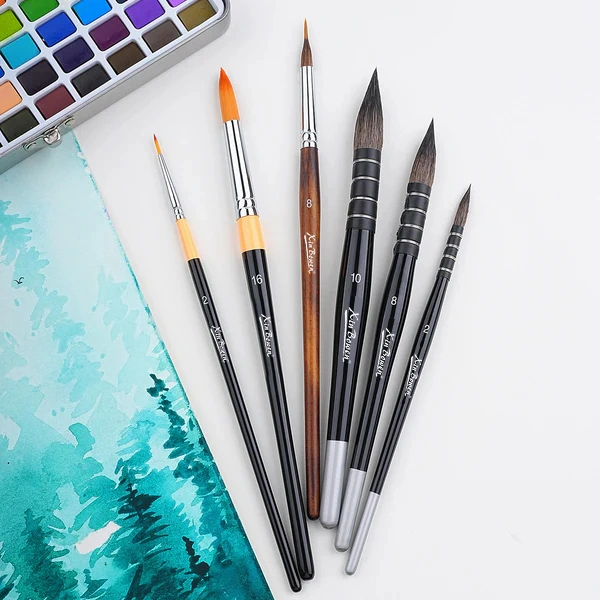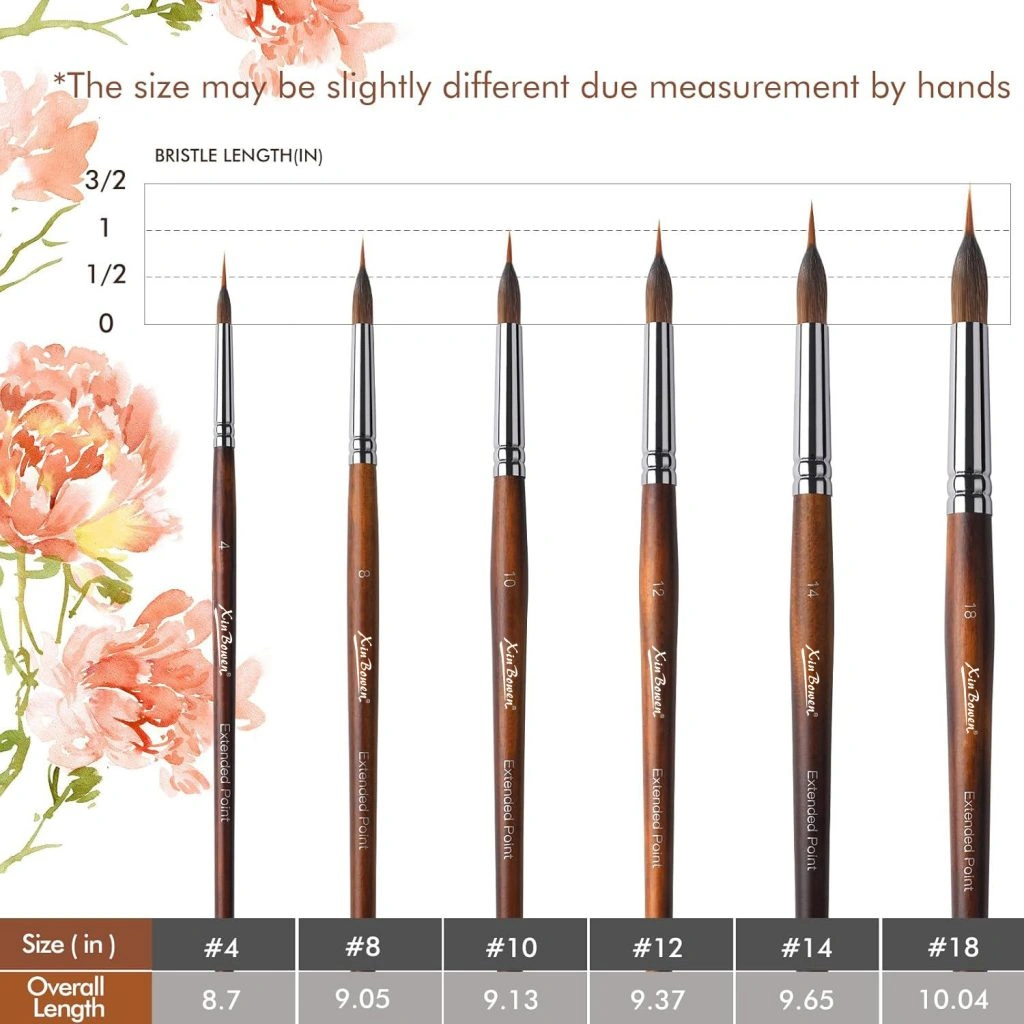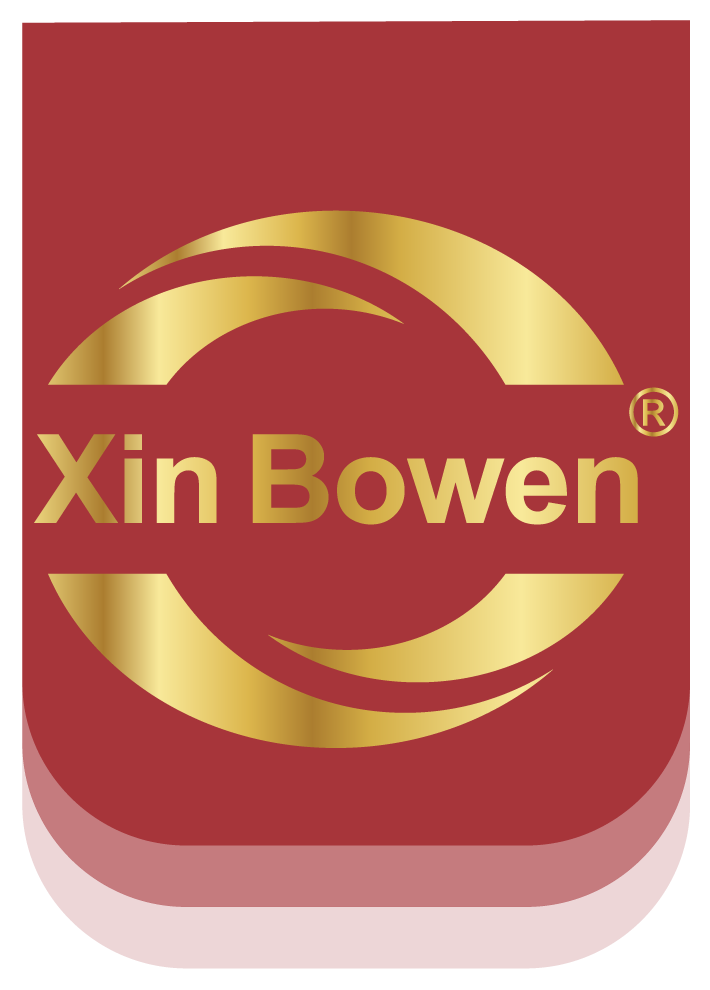What animal hair types are used in watercolor brushes, and how do they differ?
Why does animal hair matter in watercolor brush performance?
Animal hair counts a lot in how a watercolor brush works. It changes the water hold, spring, and soft feel. These three things hit the painter’s power to control color flow, make exact strokes, and keep smooth shifts. Brushes from real animal hair often hold more water and color. This makes them better for smooth changes and big washes. For example, Kolinsky sable is known for its mix of soft and strong. It gives good snap and control.
When picking a high-quality work animal hair watercolor brush, knowing the parts of each hair type helps artists fit tools to their painting way. This can be detailed line work or wide air washes.
What are the main types of animal hair used?
Many key types of animal hair go in pro watercolor brushes. Each fits different art aims.
- Kolinsky sable: This is seen as the top pick by watercolor fans. Kolinsky sable brushes give good snap, water room, and long life. Their fine points make them fit for detail and control work.
- Red sable: A bit less fine than Kolinsky. Red sable still gives high work. It is softer and more bendable. But it keeps a good point and mid snap.
- Squirrel: Known for its top soft and water-holding power. Squirrel hair fits wash ways and back layers. But it misses the spring in sable brushes.
- Goat: Goat hair is soft and takes in too. But it gives even less spring than a squirrel. It often goes in mop brushes for big area use.
How to choose based on painting style and technique?
Fitting your brush to the paint style gives the best end and easy use. For high detail work, like a plant picture or exact line art, Kolinsky or red sable brushes fit. They have good snap and point hold. If your style goes to show or no form paint with flow backs, squirrel or goat hair brushes do well. They have top water carry power.
How do watercolor brush sizes affect control and coverage?
What sizing systems are used for watercolor brushes?
Watercolor brush sizes use number marks like #0 to #24. But these numbers can change depending on the makers ‘ different rules. Brush shape hits seen size too. Round brushes put color in fine points. Flat or mop brushes spread color over wide faces.
Knowing both size, number, and shape helps artists make smart picks. This rests on the need for the detail level or area coverage.
How to select the right size for your painting needs?
Pick the right brush size to better hold the line exactly and paint the cover.
- Small sizes (#0–#4): Best for hard details like lights or face parts.
- Medium sizes (#6–#10): Bend picks fit for general paint.
- Large sizes (#12+): Fit for big washes, skies, or backs.
In the Xin Bowen 6pcs Quality Animal Fur Watercolor Paintbrushes Set For Artist, sizes go from #2 to #16 over mop, round, and needle shapes. Hair is long from 1.0 to 4.2 cm. Total length up to 23.3 cm. This set gives bend for big plans and a detailed end touch.

What does “snap” mean in an animal hair watercolor brush?
Why is snap important when choosing a natural hair brush?
“Snap” means brush power to go back to the start shape after a bend in the stroke. High snap makes sure the same line is good. It lets you hold better for repeat or hard moves. A brush with no snap may make no even strokes or lose point over time. This happens under push.
For artists who need exact details in writing or fine detail, the snap is a key part of an animal hair watercolor brush.
Which animal hairs offer good snap characteristics?
Kolinsky sable gives the best snap in all real hairs. It’s firm but bendable, built to hold exactly without losing flow. Red sable gives a fair snap, too. But it tends to bend more than Kolinsky. Squirrel and goat hairs are too soft for a big snap. They’re better for ways that put flow over exact.
At Xin Bowen, we pay close attention to this part. We shape each brush by hand. This makes sure the same points and best snap over our product range. Our quality inspection team will strictly control the procurement and production processes to maintain consistency in snap performance throughout usage.
How can I identify a high-quality animal hair watercolor brush?
What construction details signal superior craftsmanship?
High-quality brushes show many built-in parts. Hand-tied ferrules ensure a safe bristle line. Painting wood handles gives a sense of balance. Same bristle taper for exact strokes. Hand shape tips raise color flow. They stop fighting over time.
Brushes with these traits work just as well over different means. They fight to break even with repeated cleanings.
Why does Xin Bowen emphasize craftsmanship in every brush?
At Xin Bowen, we put old craft into new making to give trusted artist tools. More than 15 years of experience in production and customization have let us refine our techniques over time. We pay attention to every link of procurement, production, and customization. This makes sure each
Why choose Xin Bowen animal hair watercolor brushes for your artwork?
What sets Xin Bowen apart in quality and performance?
Xin Bowen stands out from our promise to get, make, and pack. Before shipment, we will conduct strict inspections on every production and packaging link to ensure that the products meet international standards and safety requirements. Our brushes keep their shape after repeated use. Each strand is lined with exact for long life.
They have a good water load power key for mixing and layering ways. This must be for artists to focus on the air deep or the tone change.
Which series from Xin Bowen meets different artistic needs?
Xin Bowen gives many series fit to change paint styles.
- The Xin Bowen 6pcs Quality Animal Fur Watercolor Paintbrushes Set For Artist has mop, round, and needle shapes fit for both beginners and pros.
- The Xin Bowen 6pcs Squirrel Hair Nylon Liner Watercolor Gouache Brushes Setmixes soft with build. Perfect for fine lines and smooth changes.

Both sets are packed in green boxes with picks for the custom OEM pack. These parts make them a high fit not just for one artist but for art schools, studios, wholesalers, and sellers worldwide.
Our products are mainly exported to international markets such as Europe, North America, South America, and the Middle East. This shows our world reach and name at the top.
FAQ
Q: How do I choose the best animal hair watercolor brush for detailed work?
A: For detailed work such as line art or fine textures, Kolinsky sable brushes are ideal due to their excellent snap and point retention. Red sable is a more flexible alternative with good control as well.
Q: Which type of animal hair watercolor brush holds the most water?
A: Squirrel hair holds the most water among natural hairs, making it ideal for washes and background fills. Goat hair also offers high water retention but less control due to its limited snap.
Q: What’s the difference between Kolinsky sable vs red sable brushes?
A: Kolinsky sable offers superior snap, point precision, and durability—ideal for professionals requiring control. Red sable provides similar benefits but is slightly softer and more flexible.
Q: Are synthetic brushes as good as natural animal hair brushes?
A: High-quality synthetic brushes can mimic some properties of animal hairs, like softness or water retention, but generally lack the snap and durability of premium natural hairs, such as Kolinsky sable.
Q: What features should I look for when buying an animal hair watercolor brush?
A: Look for hand-shaped tips, secure ferrules (preferably copper), ergonomic wooden handles, consistent bristle tapering, and good spring or snap, depending on your painting needs. Customizable sets like those from Xin Bowen offer tailored options for various techniques.






